-
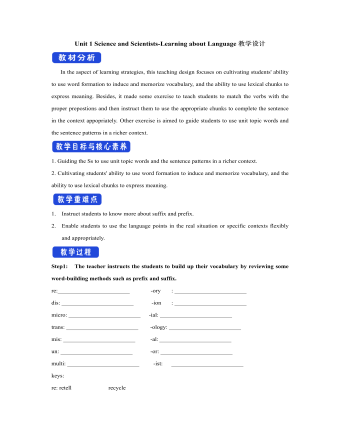
新人教版高中英语选修2Unit 1 Science and Scientists-Learning about Language教学设计
Step 7: complete the discourse according to the grammar rules.Cholera used to be one of the most 1.__________ (fear) diseases in the world. In the early 19th century, _2_________ an outbreak of cholera hit Europe, millions of people died. But neither its cause, 3__________ its cure was understood. A British doctor, John Snow, wanted to solve the problem and he knew that cholera would not be controlled _4_________ its cause was found. In general, there were two contradictory theories 5 __________ explained how cholera spread. The first suggested that bad air caused the disease. The second was that cholera was caused by an _6_________(infect) from germs in food or water. John Snow thought that the second theory was correct but he needed proof. So when another outbreak of cholera hit London in 1854, he began to investigate. Later, with all the evidence he _7_________ (gather), John Snow was able to announce that the pump water carried cholera germs. Therefore, he had the handle of the pump _8_________ (remove) so that it couldn't be used. Through his intervention,the disease was stopped in its tracks. What is more, John Snow found that some companies sold water from the River Thames that __9__________________ (pollute) by raw waste. The people who drank this water were much more likely _10_________ (get) cholera than those who drank pure or boiled water. Through John Snow's efforts, the _11_________ (threaten) of cholera around the world saw a substantial increase. Keys: 1.feared 2.when 3. nor 4.unless 5.that/which 6.infection 7.had gathered 8.removed 9.was polluted 10.to get 11. threat
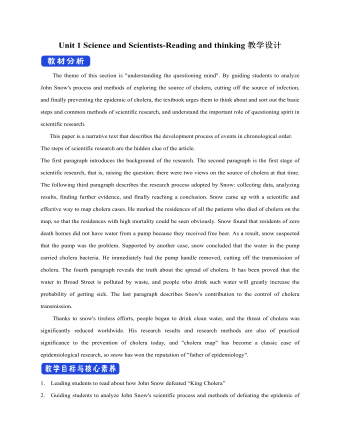
新人教版高中英语选修2Unit 1 Science and Scientists-Reading and thinking教学设计
Step 5: After learning the text, discuss with your peers about the following questions:1.John Snow believed Idea 2 was right. How did he finally prove it?2. Do you think John Snow would have solved this problem without the map?3. Cholera is a 19th century disease. What disease do you think is similar to cholera today?SARS and Covid-19 because they are both deadly and fatally infectious, have an unknown cause and need serious public health care to solve them urgently.keys:1. John Snow finally proved his idea because he found an outbreak that was clearly related to cholera, collected information and was able to tie cases outside the area to the polluted water.2. No. The map helped John Snow organize his ideas. He was able to identify those households that had had many deaths and check their water-drinking habits. He identified those houses that had had no deaths and surveyed their drinking habits. The evidence clearly pointed to the polluted water being the cause.3. SARS and Covid-19 because they are both deadly and fatally infectious, have an unknown cause and need serious public health care to solve them urgently.Step 6: Consolidate what you have learned by filling in the blanks:John Snow was a well-known _1___ in London in the _2__ century. He wanted to find the _3_____ of cholera in order to help people ___4_____ it. In 1854 when a cholera __5__ London, he began to gather information. He ___6__ on a map ___7___ all the dead people had lived and he found that many people who had ___8____ (drink) the dirty water from the __9____ died. So he decided that the polluted water ___10____ cholera. He suggested that the ___11__ of all water supplies should be _12______ and new methods of dealing with ____13___ water be found. Finally, “King Cholera” was __14_____.Keys: 1. doctor 2. 19th 3.cause 4.infected with 5.hit 6.marked 7.where 8.drunk 9.pump 10.carried 11.source 12.examined 13.polluted 14.defeatedHomework: Retell the text after class and preview its language points
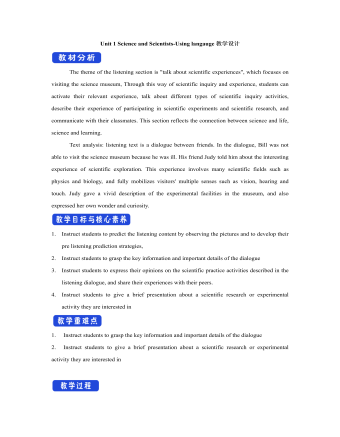
新人教版高中英语选修2Unit 1 Science and Scientists-Using langauge教学设计
This happens because the dish soap molecules have a strong negative charge, and the milk molecules have a strong positive charge. Like magnets, these molecules are attracted to each other, and so they appear to move around on the plate, taking the food coloring with them, making it look like the colors are quickly moving to escape from the soap.Listening text:? Judy: Oh, I'm so sorry that you were ill and couldn't come with us on our field trip. How are you feeling now? Better?? Bill: Much better, thanks. But how was it?? Judy: Wonderful! I especially liked an area of the museum called Light Games.it was really cool. They had a hall of mirrors where I could see myself reflected thousands of times!? Bill: A hall of mirrors can be a lot of fun. What else did they have?? Judy: Well, they had an experiment where we looked at a blue screen for a while, and then suddenly we could see tiny bright lights moving around on it. You'll never guess what those bright lights were!? Bill: Come on, tell me!? Judy: They were our own blood cells. For some reason, our eyes play tricks on us when we look at a blue screen, and we can see our own blood cells moving around like little lights! But there was another thing I liked better. I stood in front of a white light, and it cast different shadows of me in every color of the rainbow!? Bill: Oh, I wish I had been there. Tell me more!? Judy: Well, they had another area for sound. They had a giant piano keyboard that you could use your feet to play. But then, instead of playing the sounds of a piano, it played the voices of classical singers! Then they had a giant dish, and when you spoke into it, it reflected the sound back and made it louder. You could use it to speak in a whisper to someone 17 meters away.? Bill: It all sounds so cool. I wish I could have gone with you? Judy: I know, but we can go together this weekend. I'd love to go there again!? Bill: That sounds like a great idea!
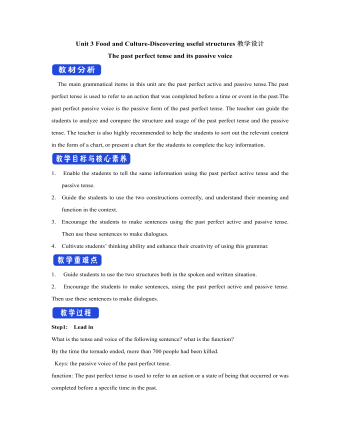
新人教版高中英语选修2Unit 3 Food and Culture-Discovering useful structures教学设计
The newspaper reported more than 100 people had been killed in the thunderstorm.报纸报道说有一百多人在暴风雨中丧生。(2)before、when、by the time、until、after、once等引导的时间状语从句的谓语是一般过去时,以及by、before后面接过去的时间时,主句动作发生在从句的动作或过去的时间之前且表示被动时,要用过去完成时的被动语态。By the time my brother was 10, he had been sent to Italy.我弟弟10岁前就已经被送到意大利了。Tons of rice had been produced by the end of last month. 到上月底已生产了好几吨大米。(3) It was the first/second/last ... time that ...句中that引导的定语从句中,主语与谓语构成被动关系时,要用过去完成时的被动语态。It was the first time that I had seen the night fact to face in one and a half years. 这是我一年半以来第一次亲眼目睹夜晚的景色。(4)在虚拟语气中,条件句表示与过去事实相反,且主语与谓语构成被动关系时,要用过去完成时的被动语态。If I had been instructed by him earlier, I would have finished the task.如果我早一点得到他的指示,我早就完成这项任务了。If I had hurried, I wouldn't have missed the train.如果我快点的话,我就不会误了火车。If you had been at the party, you would have met him. 如果你去了晚会,你就会见到他的。

新人教版高中英语选修2Unit 3 Food and Culture-Reading and thinking教学设计
The discourse explores the link between food and culture from a foreign’s perspective and it records some authentic Chinese food and illustrates the cultural meaning, gerography features and historic tradition that the food reflects. It is aimed to lead students to understand and think about the connection between food and culture. While teaching, the teacher should instruct students to find out the writing order and the writer’s experieces and feelings towards Chinese food and culture.1.Guide the students to read the text, sort out the information and dig out the topic.2.Understand the cultural connotation, regional characteristics and historical tradition of Chinese cuisine3.Understand and explore the relationship between food and people's personality4.Guide the students to use the cohesive words in the text5.Lead students to accurately grasp the real meaning of the information and improve the overall understanding ability by understanding the implied meaning behind the text.1. Enable the Ss to understand the structure and the writing style of the passage well.2. Lead the Ss to understand and think further about the connection between food and geography and local character traits.Step1: Prediction before reading. Before you read, look at the title, and the picture. What do you think this article is about?keys:It is about various culture and cuisine about a place or some countries.
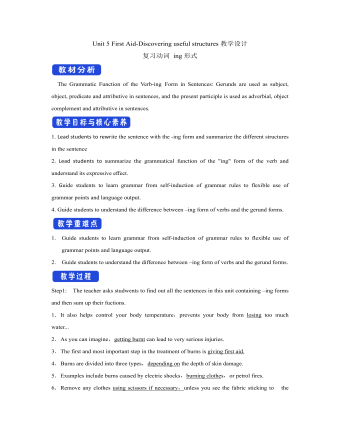
新人教版高中英语选修2Unit 5 First Aid-Discovering useful structures教学设计
You have no excuse for not going.你没有理由不去。He was punished for not having finished his homework.他因未完成作业而受到惩罚。2.动词ing形式复合结构由物主代词或人称代词宾格、名词所有格或普通格加动词ing,即“sb./sb.'s+doing”构成。动词ing形式的复合结构实际上是给动词ing形式加了一个逻辑主语。动词ing形式的复合结构有四种形式:①形容词性物主代词+动词ing②名词所有格+动词ing③代词宾格+动词ing④名词+动词ingHer coming to help encouraged all of us.她来帮忙鼓舞了我们所有人。The baby was made awake by the door suddenly shutting.这个婴儿被突然的关门声吵醒了。Can you imagine him/Jack cooking at home?你能想象他/杰克在家做饭的样子吗?无生命名词无论是作主语还是作宾语都不能用第②种形式。Tom's winning first prize last year impressed me a lot.汤姆去年得了一等奖使我印象深刻。Do you mind my/me/Jack's/Jack leaving now?你介意我/杰克现在离开吗?Excuse me for my not coming on time.很抱歉我没能按时来。His father's being ill made him worried.他父亲病了,他很担心。We are looking forward to the singer's/the singer to give us a concert.我们盼望着这位歌手来给我们举办一场演唱会。
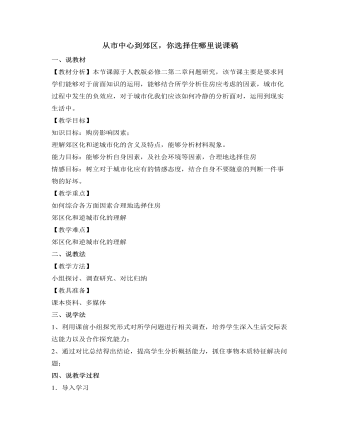
人教版高中地理必修2从市中心到郊区,你选择住哪里说课稿
课前活动:分成四组,对南京三个住房地段进行调查,新街口夫子庙、板仓、仙林,对住房居民进行问卷调查,自行设计调查问卷,分析该地段的房价要求,居民的要求,居民为何要在该地段购买住房,基础设施设置等等其它与居民购房有关的因素。◆设计意图:利用课前小组探究形式对所学问题进行相关调查,不仅让学生掌握知识了解知识来源于社会还能培养学生深入生活交际表达能力以及合作探究能力;3.问题设计同学们,不知道你们在调查过程中是否发现一个问题,郊区的房子,特别是别墅,都是些高档居所,许多有钱人的居住场所,那为什么会这样呢?伴随着城市化进程中居民都往城里挤,为什么还会有许多有钱人往郊区搬呢?这就是我们今天要研究的第二个问题:逆城市化。◆设计意图:承转过渡知识,从购房选择因素的学习过渡到郊区化的学习,同时培养学生发现问题的能力,给学生以启迪。
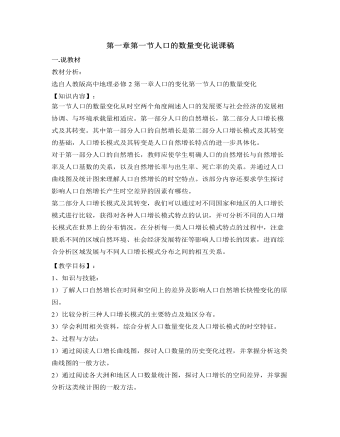
人教版高中地理必修2第一章第一节人口的数量变化说课稿
活动一:课本第三页的活动题,把学生分成几组然后让他们读图讨论,思考书上的几个问题,最后派个代表回答问题.最后教师做适当的补充:人口的自然增长不仅与人口自然增长率有关,而且还与人口基数有关.活动二:课本第七页的活动,先让两位学生阅读第六页的案例结合活动题思考问题,让几个组学生讨论所给的几个问题.让学生归纳最后教师做适当的补充.时间安排:由于本节内容不难因此整个教学过程是一节课的时间来完成的因此在教学过程中注意时间的把握,在做活动和讨论时注意把握时间,自己尽量少说废话.课堂小结通过这一节的学习,同学们正确理解和认识人口增长,增长模式和人口增长模式的转变。我们可以利用比较法、分析法来掌握,并联系现实生活,进行分析、判断,化理论知识于实践之中。
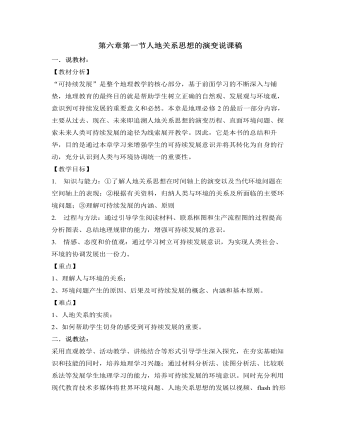
人教版高中地理必修2第六章第一节人地关系思想的演变说课稿
四、说教学过程:1、导入新课:以视频形式导入新课,说明环境问题产生原因,引出人地关系的重要性2、新课讲授:学习主题一:过去——人地关系的历史回顾以动画形式展现人地关系思想的发展,激发学生学习本专题的兴趣,归纳人与自然关系的演变过程。学习主题二:现状——直面环境问题以人类与环境关系模式图说明环境问题产生的原因,人地关系实质;以因果联系框图培养学生判读方法,了解人口、资源与环境三者之间的关系;通过阅读课文,了解环境问题的类型及其空间差异的表现;以图表了解不同国家和地区环境问题在空间轴上的表现;以《京都议定书》为引子说明保护环境是全人类的共同使命学习主题三:未来——可持续发展展示“可持续发展示意图”理解可持续发展内涵、原则
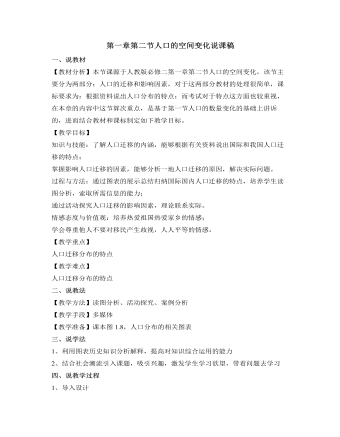
人教版高中地理必修2第一章第二节人口的空间变化说课稿
一、说教材【教材分析】本节课源于人教版必修二第一章第二节人口的空间变化,该节主要分为两部分:人口的迁移和影响因素,对于这两部分教材的处理很简单,课标要求为:根据资料说出人口分布的特点;而考试对于特点这方面也较重视,在本章的内容中这节算次重点,是基于第一节人口的数量变化的基础上讲诉的,进而结合教材和课标制定如下教学目标。【教学目标】知识与技能:了解人口迁移的内涵,能够根据有关资料说出国际和我国人口迁移的特点;掌握影响人口迁移的因素,能够分析一地人口迁移的原因,解决实际问题。过程与方法:通过图表的展示总结归纳国际国内人口迁移的特点,培养学生读图分析,索取所需信息的能力;通过活动探究人口迁移的影响因素,理论联系实际。情感态度与价值观:培养热爱祖国热爱家乡的情感;学会尊重他人不要对移民产生歧视,人人平等的情感。【教学重点】人口迁移分布的特点
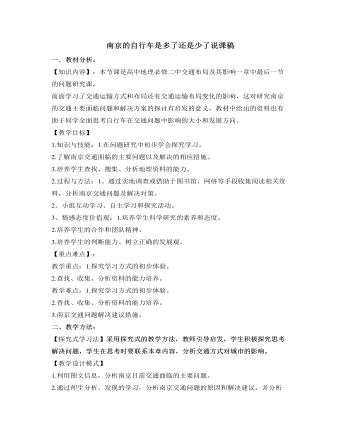
人教版高中地理必修2南京的自行车是多了还是少了说课稿
在学生回答的基础上进行归纳小结:发展城市公共交通? 明确道路分工? 合理规划停车场? 减少出行距离? 错开出行高峰? 加大城市道路建设? 进行科学合理的交通管理,重视智能交通系统的建设提问:这组同学在幻灯片中提到城市环境污染源主要有哪些?城市交通环境问题除了交通工具的尾气排放带来大气污染外,还会给城市环境带来什么问题?这组同学基本同意自行车多是加剧南京空气污染的间接原因,你同意他们的观点吗?在学生回答的基础上,教师进行归纳小结:自行车是一种绿色交通工具,既环保又经济。只有当它在某些机动车和非机动车不分的地段,影响车辆行驶速度的时候,它才可能成为加剧空气污染的间接原因。那么我们针对交通工具对环境造成的影响,除了这组同学提到的三点解决措施以外,我们还有什么要补充的解决方法吗?

人教版新课标高中地理必修2第一章第一节人口的数量变化教案
材料四:印度提倡“只生一个好”——鼓励三人小家庭 生男生女都一样材料五:印度尼西亚《人口发展与幸福家庭法》材料六:我国基本国策 计划生育(小结)通过对以上材料的分析我们可以得出这样的结论,不同的国家应该采取不同的人口政策,对与发达国家来说人口增长缓慢,应采取鼓励生育,吸引移民的措施;发展中国家人口增长较快,实行控制人口的政策已经迫在眉睫。不论是发达国家还是发展中国家共同的目标就是实现环境人口和社会经济的协调发展。【课堂小结】这节课我们主要学习了人口的自然增长,影响人口自然增长的因素有哪些?(人口的自然增长率和人口的基数)世界人口的数量在不同的历史时期表现出不同的特征,同一历史时期的不同地区,人口数量的增长又有不同的特点。面对不同的人口形势,各国应采取不同的人口政策。
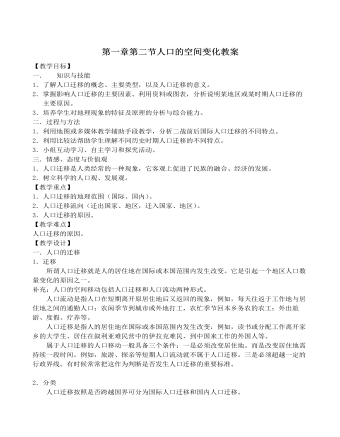
人教版新课标高中地理必修2第一章第二节人口的空间变化教案
1.促使美国成为一个移民国家的因素是:①美洲属于未开发的新大陆,需要大量的劳动力;②欧洲失业工人和破产农民增加,人们为了追求更好的经济待遇迁往美洲;③新航线的开辟为人们顺利迁移扫除了障碍;④殖民扩张是人口迁移的促进因素,加快了人口迁移的过程。导致美国人口在本土范围内频繁迁移的原因,归纳起来有:第一次人口迁移是战争因素,第二次是城市化;第三次是自然环境、经济环境的变化;第四次是经济格局的变化,即西部和南部新资源的发现和新兴工业的发展。2.我国古代的人口迁移,深受统治者及其行政力量的束缚。封建帝王为了加强本国的经济和军事实力,对人口迁移严加控制。只有当战乱发生的时候,这种控制才得到削弱,人们为了躲避战乱,寻找安定的生活环境,不得不进行大规模的迁移。我国近几十年的人口迁移主要是由生产资料和劳动力数量上的地区分布不平衡造成的,是经济因素在起主导作用,与古代的人口迁移截然不同。
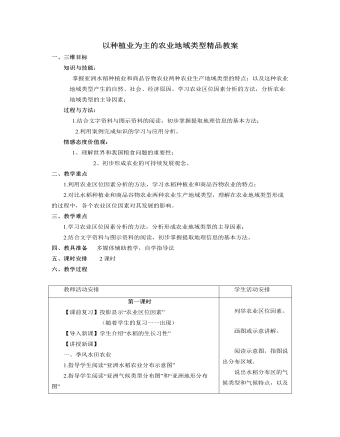
人教版高中地理必修2以种植业为主的农业地域类型精品教案
知识与技能:掌握亚洲水稻种植业和商品谷物农业两种农业生产地域类型的特点;以及这种农业地域类型产生的自然、社会、经济原因。学习农业区位因素分析的方法,分析农业地域类型的主导因素;过程与方法:1.结合文字资料与图示资料的阅读,初步掌握提取地理信息的基本方法;2.利用案例完成知识的学习与应用分析。情感态度价值观:1、理解世界和我国粮食问题的重要性;2、初步形成农业的可持续发展观念。二、教学重点1.利用农业区位因素分析的方法,学习水稻种植业和商品谷物农业的特点;2.对比水稻种植业和商品谷物农业两种农业生产地域类型,理解在农业地域类型形成的过程中,各个农业区位因素对其发展的影响。三、教学难点1.学习农业区位因素分析的方法,分析形成农业地域类型的主导因素;2.结合文字资料与图示资料的阅读,初步掌握提取地理信息的基本方法。

人教版高中地理必修2以畜牧业为主的农业地域类型教案
提问:阿根廷牧牛业以肉牛为主,那除肉牛以外还有哪种类型的牛呢?(奶牛)引入乳畜业。下面我们就来学习乳畜业。板书:二、乳畜业讲述:乳畜业随着城市发展而形成的面向城市市场的商品化、集约化畜牧业地域类型,其生产对像主要是奶牛。活动:请大家阅读52-53面内容,思考下列问题:提问:1、乳畜业产品有哪些?(牛奶及其制品)2、乳畜业主要分布在哪些地区呢?3、乳畜业是靠近消费市场好还是远离市场好?为什么?板书:1、产品种类产品:牛奶及其制品,如奶粉、黄油和奶酪。2、分布:北美洲五大湖周围地区、西欧、中欧,以及澳大利亚、新西兰等地。3、多紧邻消费市场(由于牛奶及大部分乳制品不耐贮藏,且运输不便)目前,世界上许多大城市都有奶牛农场分布于市郊。我国北京、上海等大城市周围也发展了乳畜业。活动:第53面及第54面的活动题。
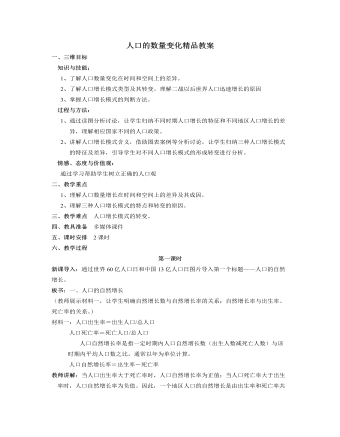
人教版高中地理必修2人口的数量变化精品教案
过渡:下面我们从时间角度分析世界人口数量变化的趋势是怎样的呢?为什么会这样呢?板书:1、人口自然增长的时间变化(引导学生读课本图1.2和图1.3,让学生分析)教师首先让学生说出阅读地理曲线统计图的一般步骤和方法,然后总结归纳:1、 读图名。2、 读各个坐标分别表示什么变量(两图横坐标均表示时间,纵坐标均为相应时期人口数)。3、 判读图形变化特征(两图中曲线曲率的变化反映对应时段内人口自然增长率的大小)。4、 思考变量之间的因果关系(两图均反映不同历史时期世界人口数量增长的不同特点)。问:世界人口数量变化的总趋势是什么?(让学生结合课本P2读图思考题,分析回答同时让学生阅读课本图1.3,在图1.2中找出图1.3所在的时段,指导学生自学P3第一段,让学生分析近100年全球人口快速增长的原因。最后师生共同归纳总结,填写下表。)

人教版高中地理必修2人地关系思想的演变精品教案
生1:公平性原则——同代人之间要公平,代际之间、人类与其他生物种群之间、不同国家与地区之间也要公平。生2:持续性原则——地球的承载力是有限的,人类的经济活动和社会发展必须保持在资源和环境的承载力之内。生3:共同性原则——发展经济和保护环境是全世界各国共同的任务,需要各国的共同参与。同时,地球作为一个整体,地区性问题往往会变为全球性问题,所以地区的决策和行动,应有助于实现全球整体的协调。活动与探究:2·阅读下面一篇新闻报道,你认为“给蛇让道”有没有必要?答:有必要·人类在森林区内修筑公路,已经侵占和破坏了蛇的生存环境,如果再不对蛇的迁移进行保护,蛇数量的减少以至灭绝将不可避免。这种做法体现了可持续发展的公平性原则和共同性原则。3·用可持续发展的观念作为衡量标准,对下列观点作出评价。(1)人类有义务保护地球上所有的物种,人类的发展不应该危及其他物种的生存。答:正确。符合可持续发展的公平性原则。

人教版高中地理必修2不同等级城市的服务功能教案
1、 前提条件:①环境几乎一样的平原地区,人口分布均匀2、 ②区域的运输条件一致,影响运输的惟一因素是距离。城市六边形服务范围形成过程。(理解)a.当某一货物的供应点只有少数几个时,为了避免竞争、获取最大利润,供应点的距离不会太近,它们的服务范围都是圆形的。 b.在利润的吸引下,不断有新的供应点出现,原有的服务范围会因此而缩小。这时,该货物的供应处于饱和。每个供应点的服务范围仍是圆形的,并彼此相切c.如果每个供应点的服务范围都是圆形相切却不重叠的话,圆与圆之间就会存在空白区。这里的消费者如果都选择最近的供应点来寻求服务的话,空白区又可以分割咸三部分,分别属于三个离其最近的供应点。[思考]①图2.15中城市有几个等级?②找出表示每一等级六边形服务范围的线条颜色?③叙述不同等级城市之间服务范围及其相互关系?3、理论基础:德国南部城市4、意义:运用这种理论来指导区域规划、城市建设和商业网点的布局。1、 应用——“荷兰圩田居民点的设置”。
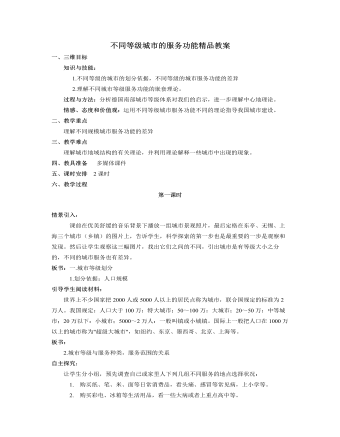
人教版高中地理必修2不同等级城市的服务功能精品教案
学生探究案例:找出不同等级城市的数目与城镇级别的关系、城镇的分布与城镇级别的关系并试着解释原因。在此基础上,指导学生一步步阅读书上的阅读材料,首先说明这是德国著名的经济地理学家克里斯泰勒对德国南部城市等级体系研究得出的中心地理论,他是在假设土壤肥力相等、资源分布均匀、没有边界的平原上,交通条件一致、消费者收入及需求一致、人们就近购买货物和服务的情况下得出的理想模式。然后指导学生阅读图2.14下文字说明,理解城市六边形服务范围形成过程。指导学生读图2.15,找出图中城市的等级、每一等级六边形服务范围并叙述不同等级城市之间服务范围及其相互关系,从而得出不同等级城市的空间分布规律,六边形服务范围,层层嵌套的理论模式。给出荷兰圩田空白图,让学生应用上面的理论规划设计居民点并说出理由,再和教材上的规划进行对照。然后给出长三角地区城市分布图和各城市人口数,让学生对这些城市进行分级,概括每一级城市的服务功能、统计每一等级城市的数目以及彼此间的平均距离,总结城市等级与服务范围、空间分布的关系?
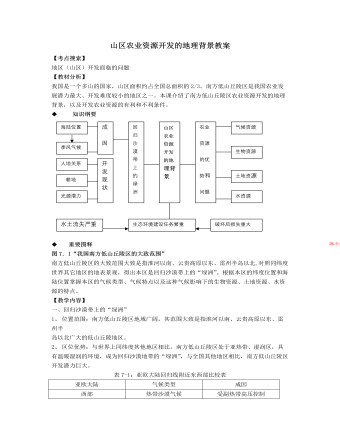
人教版高中地理选修2山区农业资源开发的地理背景教案
图7.1“我国南方低山丘陵区的大致范围”南方低山丘陵区的大致范围大致是指淮河以南、云贵高原以东、雷州半岛以北,对照同纬度世界其它地区的地表景观,得出本区是回归沙漠带上的“绿洲”。根据本区的纬度位置和海陆位置掌握本区的气候类型、气候特点以及这种气候影响下的生物资源、土地资源、水资源的特点。【教学内容】一、回归沙漠带上的“绿洲”1、 位置范围:南方低山丘陵区地域广阔,其范围大致是指淮河以南、云贵高原以东、雷州半岛以北广大的低山丘陵地区。2、 区位优势:与世界上同纬度其他地区相比,南方低山丘陵区处于亚热带、湿润区,具有温暖湿润的环境,成为回归沙漠地带的“绿洲”,与全国其他地区相比,南方低山丘陵区开发潜力巨大。